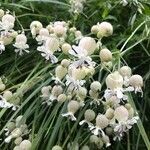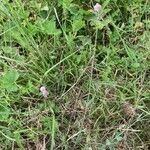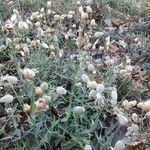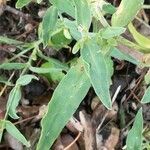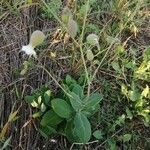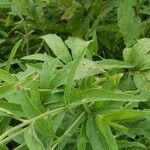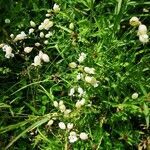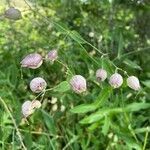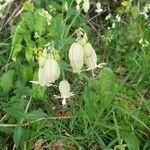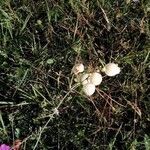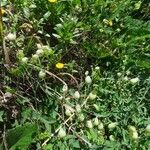Plants short-lived perennial, gla-brous, rarely pubescent, glaucous; taproot stout; caudex woody. Stems several-many, erect, branched and decumbent at base, rarely simple, 20-80 cm. Leaves mainly cauline, 2 per node, sessile, almost clasping, reduced proximal to inflorescence, blade broadly oblong to oblanceolate or lanceolate, rarely ± linear, 2-8 cm × 5-30 mm, base round, apex acute to acuminate. Inflorescences open dichasial cyme, 5-40-flowered, bracteate; bracts much-reduced, lanceolate. Pedicels 0.5-3 cm. Flowers bisexual and unisexual, some plants having bisexual flowers, others having pistillate unisexual flowers, 15-20 mm diam.; calyx pale green, rarely purplish, campanulate, not contracted at mouth or base, inflated, 9-12 mm in flower, 12-18 × 7-11 mm in fruit, herbaceous, papery, venation obscure, reticulate, without conspicuous pale commissures, margins dentate, lobes broadly triangular, 2-3 mm, glabrous; petals white, ca. 2 times as long as calyx; limb obovate, emarginate to 2-lobed; stamens exserted by 2-4 mm; styles 3, cream to greenish, at most slightly pink tinged, 2 times longer than calyx. Capsules ovoid to globose, equaling calyx, opening by 6 teeth; carpophore 2-3 mm. Seeds black or nearly so, globose-reniform, 1-1.5 mm, finely tuberculate. 2n = 24.
Herbs perennial, grayish green, 40--100 cm tall, glabrous throughout. Roots slightly robust, lignified. Stems sparsely caespitose, erect, usually gray, apically branched. Leaves lanceolate to ovate, 4--10 × 1--3(--4.5) cm, proximal cauline leaves with prominent midvein, base attenuate, apex acuminate or acute; distal leaves cuneate, slightly clasping. Flowers usually in many-flowered dichasia, sometimes in thyrsoid inflorescences; flowers sometimes spreading or slightly nutant. Pedicel shorter than or subequaling calyx; bracts ovate-lanceolate, herbaceous. Calyx usually violet-tinged, broadly ovoid, inflated, 1.3--1.6 cm × 5--7 mm, submembranous, with 20 anastomosing veins; calyx teeth broadly triangular, short, ciliate. Androgynophore ca. 2 mm, glabrous. Petals 1.5--1.8 cm; claws cuneate-oblanceolate, glabrous, auricles ovoid; limbs exserted beyond calyx, white, obovate, deeply bifid to base of limb, lobes narrowly obovate; coronal scales small. Stamens and styles prominently exserted; filaments glabrous; anthers violet. Styles 3. Capsule subglobose, ca. 8 mm in diam., shorter than calyx. Seeds globose-reniform, ca. 1.5 mm. Fl. Jun--Aug, fr. Aug--Sep. 2n = 24, 48.
Stoutly taprooted perennial. Stems ascending to erect, glabrous, swollen at nodes, (10)-30-80 cm tall. Lvs glabrous or rarely hairy on surfaces, sometimes scabrid on margins, glaucous, ovate to linear-lanceolate to oblanceolate, acute, usually very shortly connate, 1.5-10 × 0.5-2 cm; lower lvs petiolate; upper lvs sessile. Infl. a lax 1-25-(40)-flowered dichasium; pedicels 5-15 mm; bracts ovate, green or scarious. Fls ☿. Calyx glabrous, glaucous, inflated, ovoid, 13-17 mm long; veins 20, weak with fine network of secondary veins; teeth broadly triangular, acute, ciliolate. Petals white; limb deeply emarginate, sometimes with 2 small lateral lobes near base; claw lobed near base of limb; coronal scales scale-like or oblong, 0-1 mm long. Styles 3, erect, c. 2 cm long. Capsule ovoid to spherical, included in calyx, dehiscing by 6 erect or recurved teeth; carpophore 2-3 mm long. Seeds dull brown, reniform, flattened, warty, 1-1.5 mm long.
Herb, perennial, glabrous or sparsely pubescent, often glaucous. Stems erect, branching, basally woody, decumbent and caespitose, 25–90 cm long. Leaves sessile or rarely shortly petiolate, with basal leaves similar to cauline ones, ovate to linear-lanceolate, acute, 20–60 mm long, 3–12 mm wide. Inflorescence lax, usually many-flowered; bracts scarious. Pedicels often drooping, 5–30 mm long. Calyx ellipsoidal, inflated, with mouth contracted, 20–30-veined, reticulate, 8–15 mm long, ± glabrous, glaucous; calyx lobes triangular, acute. Petal limb to 10 mm long, white, pink or violet, deeply bifid. Styles 3. Capsule to 15 mm long, broadly ovoid to conical, with 6 erect teeth; carpophore c. 5 mm long, glabrous. Seeds 1–1.5 mm long, subreniform, flat or convex, black, acutely tuberculate.
lance-ovate to oblanceolate, 3–8 × 1–3 cm, abruptly acuminate, sometimes ciliolate, the cauline often clasping; infl open; cal papery, inflated and umbilicate, 1 cm in fl, accrescent to 2 cm in fr, with 20 equal main veins and also reticulate-veiny; pet white, without auricles, the appendages minute or none, the blade 3.5–6 mm, deeply bilobed; carpophore 2–3 mm; styles 3; fruit trilocular, opening by 6 teeth; 2n=24. Native of Europe, occasionally found as a weed in waste places throughout most of temperate N. Amer. Summer. (S. cucubalus; S. latifolia (Mill.) Britton & Rendle)
An erect herb. It keeps growing from year to year. It grows 30-40 cm high. It branches from the base. It is usually without hairs but covered with a waxy bloom. The leaves are oval to sword shaped. The lower leaves are sharply stalked. The upper leaves do not have leaf stalks. The flowers are white. They are carried on long drooping stalks. The sepals join to form a green tube which is fattened. It has 5 triangle shaped teeth. The petals are white and divided into 2 lobes.
Glaucous, rhizomatous perennial, up to 0.75 m high. Leaves lanceolate or oblanceolate. Flowers in cymes, white to purple; calyx inflated, 12-15 mm long; petals deeply bifid; carpophore ± 2 mm long. Flowering time Oct.-Dec.
Glaucous, rhizomatous perennial to 60 cm. Leaves lanceolate or oblanceolate. Flowers in cymes, white to purple, calyx inflated, 12-15 mm long, petals deeply bifid, carpophore ± 2 mm long.
